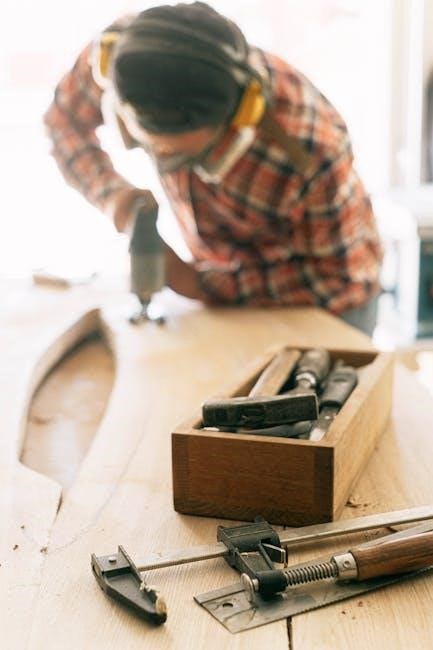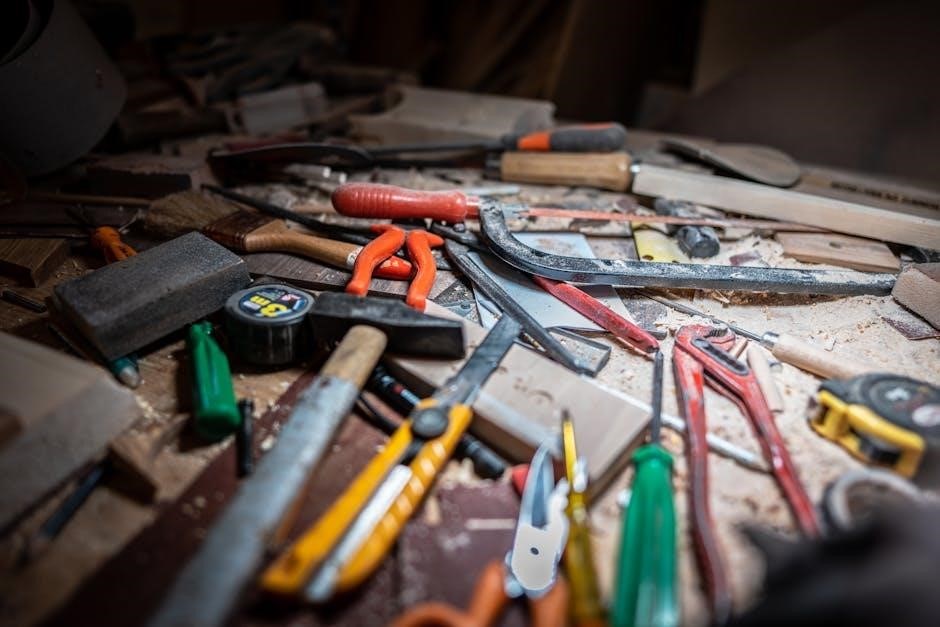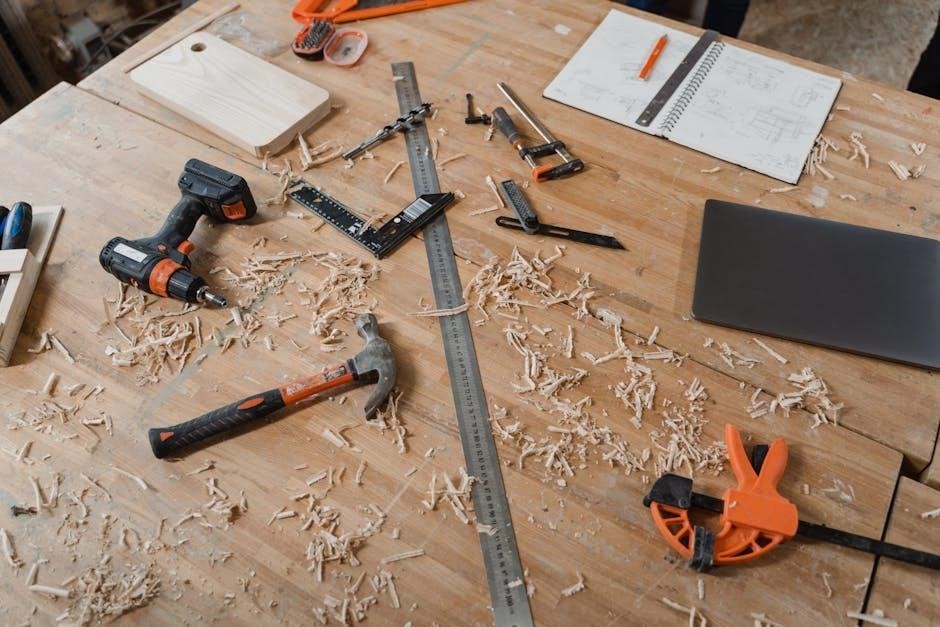A clamp and saw guide is an essential woodworking tool that enhances cutting accuracy by providing a straight-edge reference for circular saws, ensuring precise and repeatable cuts;

What is a Clamp and Saw Guide?
A clamp and saw guide is a versatile woodworking accessory designed to secure a workpiece and provide a straight-edge reference for circular saws, ensuring precise cuts. It typically features an adjustable clamp mechanism and a rigid edge guide, allowing for accurate alignment and repeatable results. This tool is ideal for various applications, including plywood rips, cabinetry, and DIY projects, offering both professionals and hobbyists improved accuracy and efficiency in their workflows.
Importance of Using a Clamp Guide in Woodworking
Using a clamp guide in woodworking is crucial for achieving precise, straight cuts and minimizing material waste. It enhances accuracy by providing a stable reference edge for circular saws, reducing human error and ensuring repeatable results. This tool is especially valuable for cutting large panels, plywood, and long boards, where handheld cuts often veer off course. By securing the workpiece firmly, it also improves safety and consistency, making it an indispensable asset for both professionals and DIY enthusiasts aiming for professional-grade outcomes.

Fundamentals of Clamp and Saw Guides
Clamp and saw guides are tools that secure tightly to workpieces, providing a straight-edge reference for circular saws to ensure precise, repeatable cuts. They consist of an extruded aluminum or steel bar with an adjustable clamp head, enabling accurate alignment and minimizing human error. This design allows for consistent results across various woodworking projects, making them a fundamental asset for both professionals and DIY enthusiasts.
How Clamp Guides Work

A clamp guide functions by securing tightly to a workpiece, providing a straight-edge reference for a circular saw’s base plate. It typically consists of an extruded aluminum or steel bar with an adjustable clamp head. To use, place the guide on the marked cutting line, align its edge with where the saw should track, and clamp it firmly. The saw’s base plate then runs along the guide, ensuring straight, precise cuts from start to finish. This mechanism reduces human error and material waste, enhancing overall cutting accuracy and efficiency in woodworking projects.
Key Components of a Clamp Guide
A clamp guide typically features a durable, extruded aluminum or steel bar for rigidity and straight-edge accuracy. It includes an adjustable clamp head with strong jaws for securing the guide to the workpiece. Non-marring pads protect surfaces from damage, while integrated measuring scales assist in layout and marking cuts. Some models offer splinter guards to reduce tear-out, especially on veneered materials. Optional extensions increase the guide’s length for handling larger panels, ensuring versatility and precision in various woodworking tasks.

Applications of Clamp and Saw Guides
Clamp and saw guides are ideal for cabinetry, flooring, shelving, and plywood rips, ensuring precise cuts in woodworking and DIY projects, enhancing efficiency and accuracy.
Common Uses in Woodworking and DIY Projects
Clamp and saw guides are widely used in woodworking for tasks like cabinetry, flooring, and shelving, ensuring precise cuts. They are ideal for ripping plywood, making cross cuts, and handling long boards. DIY enthusiasts use them for projects requiring straight edges, such as cutting panels or trimming materials. The guides are especially useful for repeatable cuts, minimizing waste and improving accuracy. They also simplify cutting angles up to 45 degrees, making them versatile for various woodworking and DIY applications.
Advantages Over Traditional Cutting Methods
Clamp and saw guides offer superior accuracy and consistency compared to traditional cutting methods. They minimize human error, reduce material waste, and enable faster workflow. By providing a stable reference edge, they ensure straight, repeatable cuts, which is crucial for professional results. These guides also eliminate the need for manual measurements, saving time and effort. Additionally, they enhance safety by keeping the saw aligned, reducing the risk of accidents. Overall, clamp guides are a cost-effective solution for achieving precise cuts in various woodworking and DIY projects.

Types of Clamp and Saw Guides
Clamp and saw guides come in adjustable, fixed, and expandable models, offering versatility for different projects. DIY and store-bought options cater to various needs and preferences.
Adjustable Clamp Guides
Adjustable clamp guides offer versatility, allowing users to modify the guide’s length or position to suit various projects. They often feature quick-adjust levers or threaded clamps for precise setups. These guides are ideal for woodworking applications requiring frequent adjustments, such as cutting multiple panels or angled cuts. Popular models include the Bora Portamate NGX and Kreg Accu-Cut, which provide durable, lightweight designs with measuring scales for added convenience. Their adaptability makes them a favorite among professionals and DIYers alike, ensuring accurate and efficient results across different tasks.
Fixed vs. Expandable Guides
Fixed clamp guides are rigid and designed for specific cutting lengths, offering stability and precision for standard woodworking tasks. Expandable guides, however, provide flexibility, allowing users to extend the guide’s length for cutting larger materials like full plywood sheets. Expandable models often feature modular extensions, making them ideal for long-panel cuts. While fixed guides are more compact and affordable, expandable guides are preferred for versatility in handling various project sizes. Products like the Bora 100 WTX and Kreg Accu-Cut exemplify these differences, catering to different user needs and workshop requirements.
DIY vs. Store-Bought Options
DIY clamp guides, such as those made from straight plywood strips, offer a cost-effective and customizable solution for occasional use. They are easy to assemble but lack the durability and precision of store-bought options. Store-bought guides, like the Bora Portamate NGX, are made from heavy-duty materials and feature adjustable clamps, measuring scales, and extensions for versatility. While DIY options save money, store-bought guides provide superior performance, longevity, and convenience for frequent woodworking tasks, making them a worthwhile investment for professionals and serious hobbyists.

Buying Tips for the Best Clamp Guide
Consider durability, adjustability, and compatibility with your tools. Look for sturdy materials, precise alignment features, and easy clamping mechanisms to ensure accuracy and versatility in woodworking projects.
Factors to Consider When Choosing a Clamp Guide
When selecting a clamp guide, consider the material durability, size compatibility, and clamping mechanism. Look for sturdy aluminum or steel frames for rigidity. Ensure the guide length matches your project needs, from narrow trim to full plywood sheets. Check for features like anti-slip strips, quick-adjust levers, or splinter guards. Compatibility with your circular saw is crucial, as is the ease of setup and alignment. Budget options vary, so balance cost with features like modular extensions or laser-etched scales for precision. Prioritize brands known for quality and durability to ensure long-term performance.
Top Product Recommendations
Top clamp guides include the Bora Portamate NGX, known for its adjustability and durability, and the Kreg Accu-Cut, offering precision with a splinter guard. DEWALT’s clamp guide is praised for its robust build and compatibility. Empire’s budget-friendly option provides excellent value without compromising performance. Shop Fox’s modular extensions are ideal for large projects. These guides are highly rated for their accuracy, ease of use, and versatility, making them standout choices for both professionals and DIYers seeking reliable cutting solutions.

Setting Up and Using a Clamp Guide
Place the guide on your marked cutting line, align the saw’s base plate with the edge, and clamp securely. Ensure the saw runs smoothly along the guide for precise cuts.
Step-by-Step Guide to Proper Installation
Begin by positioning the clamp guide along your marked cutting line, ensuring it aligns with your project’s requirements. Secure the guide firmly using the integrated clamping mechanism or additional clamps if needed. Double-check the alignment to ensure accuracy. Tighten all adjustable components to prevent movement during cutting. Finally, verify the saw’s base plate is flush with the guide’s edge before making your cut. Proper installation ensures precise, repeatable results and enhances overall safety during woodworking tasks.
Tips for Achieving Accurate Cuts
- Always align the clamp guide precisely with your marked cutting line for optimal accuracy.
- Ensure the clamp is tightly secured to prevent movement during cutting.
- Use a sharp, high-tooth blade for cleaner cuts and reduced tear-out.
- Check the saw’s base plate for proper alignment with the guide’s edge.
- Consider using a splinter guard or anti-chip strip for smoother results.
- Pre-cut checks: Verify blade depth and ensure the workpiece is properly secured.

Safety and Maintenance
Inspect the clamp guide for damage before use, wear safety gear, and store it properly to maintain effectiveness and ensure safe operations always.
Safety Precautions When Using a Clamp Guide
Always ensure the clamp guide is securely attached to the workpiece to prevent movement during cutting. Keep hands and loose clothing away from the saw blade. Wear safety glasses and a dust mask. Check the guide for damage or debris before use. Ensure the saw base is clean and properly aligned with the guide. Avoid overreaching or applying excessive pressure, which can cause loss of control. Store the guide in a dry, secure location when not in use to maintain its effectiveness and longevity.
How to Maintain Your Clamp Guide
Regularly clean the guide’s edge and clamping mechanism to ensure smooth operation. Inspect for damage or wear and replace parts as needed. Store the clamp guide in a dry, secure location to prevent rust or bending. Apply a light lubricant to moving parts to maintain functionality. Avoid exposing the guide to extreme temperatures or harsh chemicals. Periodically check the alignment and accuracy of the guide to ensure precise cuts. Proper maintenance extends the lifespan and performance of your clamp guide.

Clamp Guide vs. Track Saw
A clamp guide is an affordable, adaptable accessory for standard circular saws, while a track saw offers ultra-precise, dustless cuts with a dedicated tool and rail system.
Key Differences and Which to Choose
A clamp guide is a cost-effective, versatile accessory for standard circular saws, ideal for general woodworking and DIY projects. Track saws, however, offer superior precision and dust collection, requiring a dedicated tool and rail system. For most home users and professionals needing straight cuts, a clamp guide suffices; Opt for a track saw if you require ultra-precise, chip-free results and are willing to invest in a specialized system. Choose based on your project demands, budget, and desired level of accuracy.
A clamp and saw guide is a transformative tool for woodworkers and DIY enthusiasts, offering unmatched accuracy, efficiency, and safety in various projects. Its versatility and cost-effectiveness make it a must-have for both professionals and hobbyists. By reducing waste and improving cut quality, it elevates project outcomes. Whether for cabinetry, flooring, or large panel cuts, a clamp guide is an indispensable asset. With proper selection and use, it ensures precise, professional results, making it a worthwhile investment for any woodworking toolkit.
